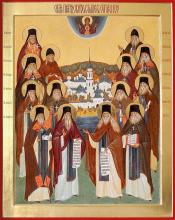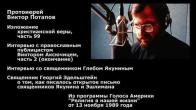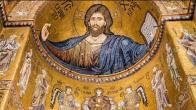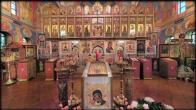You are here
The Glorification of the Assembly of the Holy Elders of Optina Monastery by the Russian Orthodox Church Abroad
10/23 October
 The Council of Bishops of the Russian Church Abroad, which was held in New York in August of 1988, resolved to glorify as saints the venerable God-pleasers, the Optina Elders. The universal celebration of the glorification of the Optina Elders took place on May 12, 1990 in the Cathedral Church of Saint Nicholas in Montreal, Canada.
The Council of Bishops of the Russian Church Abroad, which was held in New York in August of 1988, resolved to glorify as saints the venerable God-pleasers, the Optina Elders. The universal celebration of the glorification of the Optina Elders took place on May 12, 1990 in the Cathedral Church of Saint Nicholas in Montreal, Canada.
The Assembly of the Holy Elders of Optina Monastery consists of the following 14 God pleasers:
Schema-Archimandrite Moses, Hieroarchemamonk Leo, Schema-Hegumen Anthony, Hieroschemainonk Macarius, Hieroschemamonk Ambrose, Hieroschemamonk Joseph, Hieroschemamonk Anatole, Hieroschemamonk Hilarion, Schema-Archimandrite Barsanuphius, Hieroschemamonk Nectarius, Schema-Hegumen Nicon, Schema-Archimandrite Isaacius, Hieroschemamonk Anatoly (the Younger), Schema-Archimandrite Isaacius II.
Incidentally, the canonization of Elder Ambrose was previously considered during the Local Council of 1917-1918, when the patriarchate was reestablished in Russia, but because of events during the post-revolutionary years it was never held.
The impending canonization once again is drawing the world's attention to the history of Russian Orthodox eldership, which reminds us of the times of the first Christians. The activity of Optina Hermitage and its elders is an exceptionally real experience for our time also, since it is separated from us by little more than a century.
In connection with the impending glorification of the elders of Optina Hermitage, we will briefly acquaint you with the history of Optina Hermitage - that center of spiritual rebirth in the 19th century. We will mention some of its elders, and we will bring to our readers' attention a small sketch about who the elders were.
* * *
Optina Hermitage is located in what is currently known as the Kaluga Region, at a distance of only several kilometers from the district center of Kozelsk. Concerning the time of the founding of the Hermitage, no written information has been preserved. Only certain traditions exist. According to one of these, the Hermitage was founded by a repentant robber named Opta, from whom it received its name. This former robber, torn by pangs of conscience, settled in the remote, inaccessible place amidst the dense pine forests to expiate his sins in prayer. Soon, when other people heard about his solitary life, they were drawn thither seeking solitude. And so a small monastery sprung up. Another tradition exists, according to which the monastery was founded by Prince Vladimir the Brave. In any event, Optina Hermitage is one of Russia's ancient monasteries.
Written traces of Optina Hermitage date from 1603. By this time already a wooden church had been built in it, around it there were six cells, and the monastery was headed by Hieromonk Theodore. The monastery was granted land for gardens and orchards by Tsar Mikhail Fyodorovich, and also a mill not far from Kozelsk. It is known that already in 1689 a stone church in honor of the Entry Into the Temple was built in the monastery by the Shepelev boyars.
The reforms of Peter the Great told unfavorable on the Optina Hermitage. The monastery mill and land were taken by the state. The monastery became impoverished and in the middle of the 18th century was altogether suppressed. Thus ended the first period of Optina Hermitage's existence.
In 1795, Platon, the Metropolitan of Moscow, was traveling around his extensive diocese and he visited Optina. The site and the natural surroundings pleased him exceedingly, and he decided to restore the monastery. For this purpose, Abraamius, a monk from one of the monasteries near Moscow, was appointed, and he brought with him twelve monks from his monastery. At Optina Hermitage he found only three aged inhabitants, and he began to work on the monastery's restoration.
First of all, Abraamius set out to collect funds for the impoverished monastery. He brought church utensils, icons, vestments and set to work at rebuilding the hermitage. He built an infirmary and a church attached to it in honor of the Kazan Icon of the Mother of God. He built a bell-tower and cells for the monastics, and he laid out a large garden. But the main thing Abraamius did was to establish order in the monastery's spiritual life. Theophanes, the disciple of the famous Athonite ascetic Archimandrite Paisius Velichkovsky, came unto Abraamius and became an example for the brethren of the monastery. Following the example of his teacher, Theophanes together with Abraamius established a coenobitic monastery according to the rule of Mount Athos, which in a comparatively short time gained the esteem of the surrounding inhabitants.
In 1817, Hegumen Abraamius died. His place was occupied by Hegumen Daniel, who directed Optina Hermitage for a comparatively short time--from 1819 to 1825.
The flowering of Optina Hermitage is tied with the name of another superior -- Moses Putilov, who directed the monastery for 37 years, from 1826 to 1862. He can be considered one of the most prominent personalities in the history of the Russian Church during the 19th century.
Hegumen Moses was born in a devout family. He aspired to monasticism and already at the age of sixteen he set out on the path of asceticism after having received a blessing for this from Saint Seraphim of Sarov. At first he visited many monasteries, where he met still other friends and disciples of Paisius Velichkovsky. In 1821 he came to Optina Hermitage, and at the advice of the diocesan bishop, Philaret (who would later be wellknown as the Metropolitan of Kiev), he remained there in order to build a skete not far from the Hermitage. For this purpose, Moses invited his brother, Anthony, and two other monks, and in a short time a wooden church and three cells were built. These were consecrated in 1822. The bishop elevated Moses to the priestly rank of hieromonk and appointed him abbot of Optina Hermitage, while his brother was left in the skete.
Hegumen Moses displayed exceptional abilities as a builder, organizer and spritual director. He invited Leonid - a disciple of Velichkovsky - to Optina, and he became the first elder of the Hermitage.
The brethren increased significantly during the years of Moses' abbacy. While at the beginning of the twenties of the 19th century there were only 40 monastics, by the middle of the fifties their number had risen to three hundred.
Under Hegumen Moses there was established a special style of monastic attitudes that was preserved throughout all the succeeding years. Each monk, in accordance with his abilities, received one or another obedience from the abbot. While defining the essence of the obedience, the abbot would not delve into the details, leaving this to the initiative of the monk himself, which created and fostered in the brethren a certain feeling of freedom and independence. When a failure would occur, the brother always received support, advice and comfort from the abbot instead of reproaches, which likewise promoted the love and harmony for which the Hermitage was noted.
An especially great service was performed by Hegumen Moses in instituting eldership. The first elder, Leonid, each evening received the brethren, giving them words of instruction and consolation. In 1834 still another Elder, Macarius, transferred to Optina. The glory of the two Optina elders extended far beyond the bounds of the Hermitage. People came from all over the immense land of Russia for their counsel and consolation, and in this way the glory of Optina Hermitage spread throughout the whole Orthodox world.
Unto the Hermitage streamed peasants and workers, landowners, writers and thinkers, clergy and those thirsting for the monastic struggle. Through them, everything that was done in the Hermitage, and, most of all, the lives of the Optina elders became known in society and left on it a deep impression.
In May of 1862, Hegumen Moses, the superior and regenerator of Optina Hermitage, died. Under his successors, apart from those elders already mentioned, Optina Hermitage was adorned by the Elders Ambrose, Anatoly, Joseph, Barsanuphius and Nectarius, who already lived in the 20th century.
Many great people of the 19th and early 20th centuries visited Optina Hermitage. In one way or another, Optina Hermitage is reflected in the works of many Russian writers, and in their biographies.
The October Revolution of 1917 brought an end to the second period of Optina Hermitage. Strictly speaking, Optina Hermitage still continued to Eve for a certain time after the revolution, which, incidentally, the Optina elders foresaw; however, relentless pressure by the authorities quickly caused it to be extinguished. Its elders departed into eternity, and the remainder of the brethren were expelled. The buildings of the Hermitage were utilized for a children's home, for holding juvenile delinquents.
In 1988, Optina Hermitage was returned to the Moscow Patriarchate and at the current time its restoration is going ahead at full speed. In the same year, the Optina Elder Ambrose was canonized at the Trinity-Sergius Lavra during the celebration commemorating the millennium of the Baptism of Russia.
Now, with its return to the Church, the third period of Optina's history is beginning. Let us beseech the Lord that new Abraamius' and Moses' will be found who will raise it up from ruins, and that new elders, in the spirit of Leonid, Anatoly, Ambrose and Nectarius, will spiritually nourish the multitude of pilgrims that undoubtedly will again head for the newly opened monastery. May God grant that Optina will once again become a center for the spiritual rebirth of the much-suffering Russian land.
Washington, D.C., 1990
Lessons from the Fathers:
Relics in cathedral - monthly calendar
| S | M | T | W | T | F | S |
|---|---|---|---|---|---|---|
|
|
|
|
1
|
2
|
3
|
4
|
|
5
|
6
|
7
|
8
|
9
|
10
|
11
|
|
12
|
13
|
14
|
15
|
16
|
17
|
18
|
|
19
|
20
|
21
|
22
|
23
|
24
|
25
|
|
26
|
27
|
28
|
29
|
30
|
31
|
|
PARISH LIFE
Address of our Cathedral
While all the materials on this site are copyrighted, you may use them freely as long as you treat them
with respect and provide attribution on the Russian Orthodox Cathedral of St.John the Baptist of Washington DC.









